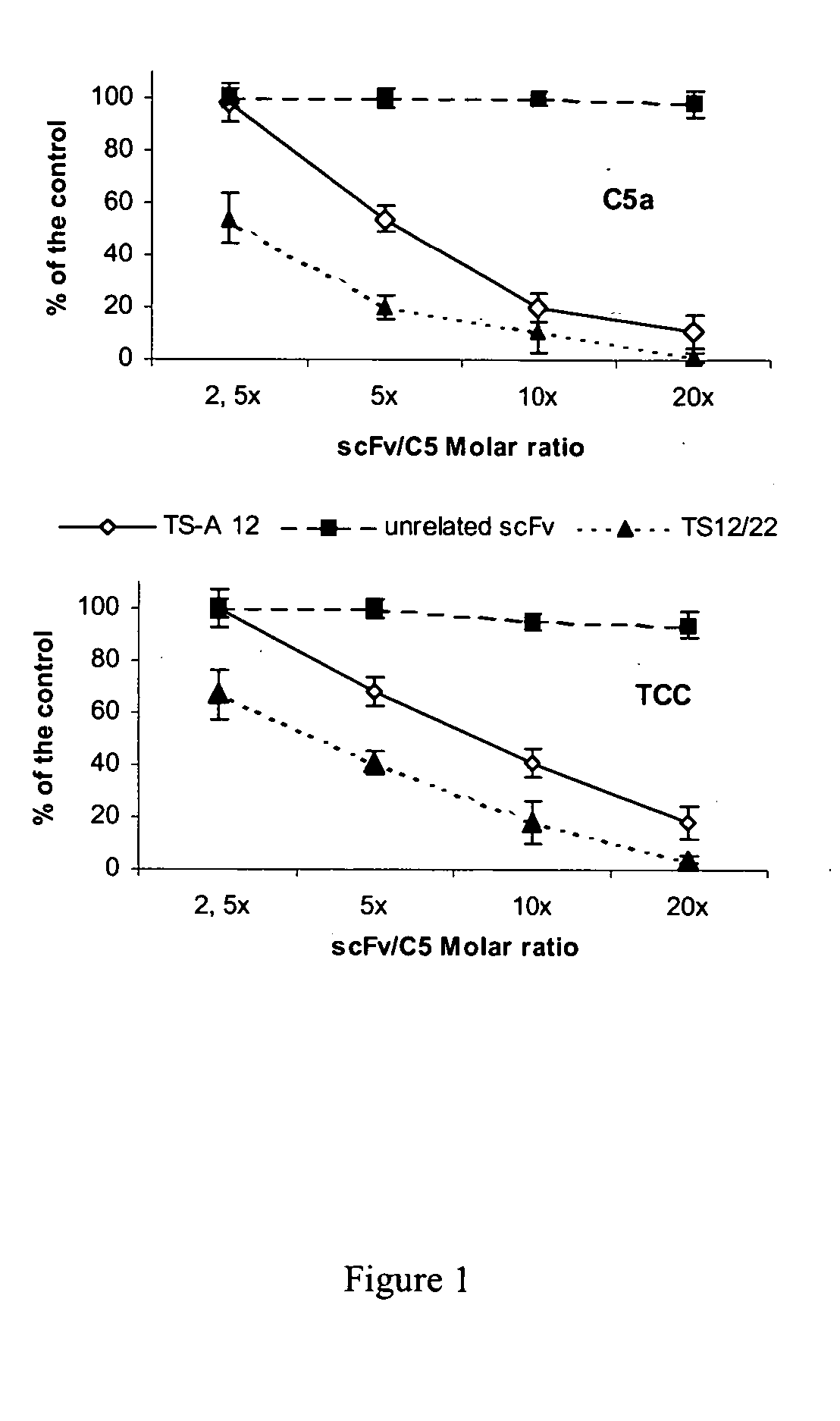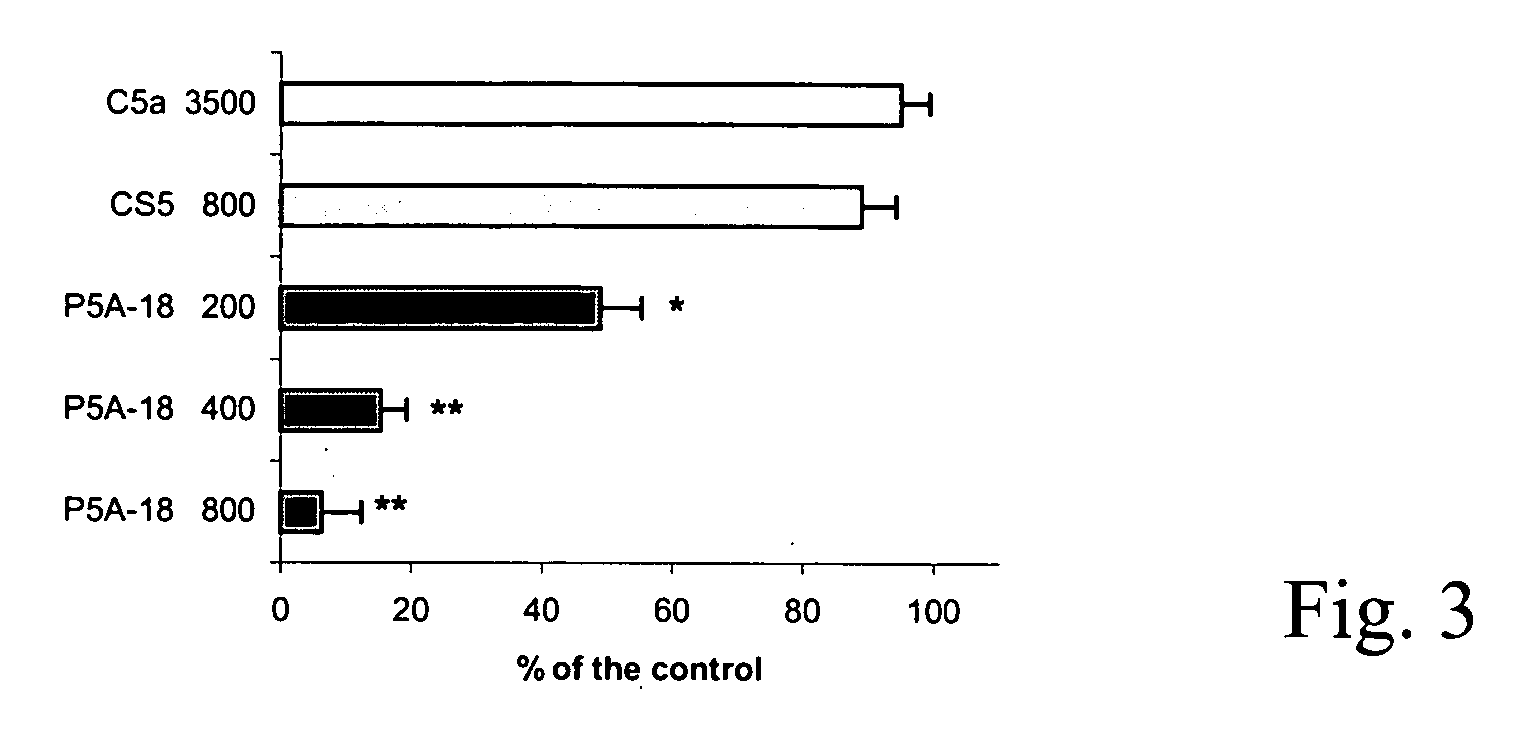Antibodies anti-c5 component of the complement system and their use
a complement system and anti-c5 technology, applied in the direction of antibody medical ingredients, drug compositions, pharmaceutical active ingredients, etc., can solve the problems of complement causing tissue and cell damage, over-aggressive inhibitory action, and causing serious damage to tissues and cells
- Summary
- Abstract
- Description
- Claims
- Application Information
AI Technical Summary
Benefits of technology
Problems solved by technology
Method used
Image
Examples
example 1
Amplification and Selection of Phage Library
[0082] Phages were obtained and amplified as described in Marks, J. D. et al., 1991, J. Mol. Biol. 222:581. The selection was performed in “immunotubes”. (Nunc, Mascia Brunelli, MI, IT) coated with purified C5 protein. Coating of “immunotubes” was obtained by incubation with a C5 solution (10 μg / ml in PBS) overnight at 4° C. Phages were diluted in PBS containing 2% non-fat dry milk (MPBS) and incubated in immuno-tubes for 60 minutes at room temperature. After incubation, the immunotubes were washed 20 times with PBS containing 0.1% Tween 20 (PBST) and 20 times with PBS. The phage particles bound to immunotubes were eluted with 1 ml of E. coli bacterial culture at a density of 0.5 OD600 for 30 minutes at 37° C. Ampicillin (75 μg / ml), helper phage and kanamycin (25 μg / ml) were then added and the culture was grown overnight.
[0083] After a second selection cycle on C5 coated immunotubes, eluted E. coli cells were amplified to extract phagemi...
example 2
Isolation of Phage Particles with Binding Specificity for the C5 Antigen
[0084] The phage particles obtained after three cycles of C5 “panning” in immunotubes (as described in Example 1), were used to infect E. coli cells grown on solid medium. Single bacterial colonies were transferred in 96-well plates and the resulting phages were further tested by ELISA for their ability to bind C5. The C5 antigen, at a concentration of 10 μg / ml in 0.1 M bicarbonate buffer pH 9.6, was bound to the plates by overnight incubation at 4° C. After saturation of plates with MPBS (PBS containing 2% non-fat dry milk), 50 μl of phage suspension were diluted with an identical volume of MPBS; a monoclonal antibody anti-pill (M13 protein) conjugated to HRP (Pharmacia Biotech) was then added. Positive binding was revealed by addition of H2O2 and 3,3′,5,5′-thetramethylbenzidine diclorate (Sigma-Aldrich) as substrate and absorbance at 450 nm by spectrophotometric reading.
[0085] Positive clones by the ELISA as...
example 3
Preparation of Soluble Single Chain ScFv Antibodies
[0086] Phage clones obtained as described in Example 2 were used to infect the E. coli strain HB2151 to obtain expression of scFv fragments in soluble form. Bacteria grown until O.D. 0.5 in 2XYT medium, containing ampicillin, were induced with isopropil-β-tiogalattopiranoside and further grown for 5 hours. The periplasmic fraction containing scFv antibodies was prepared by incubation with B-PER reagent (Pierce, Celbio, MI, IT) for 20 minutes at RT, followed by centrifugation for 15 minutes at 27000×g. The supernatant was dialyzed against PBS and single chain antibodies containing the poly-histidine tail at the C-terminus were purified by affinity chromatography on nickel Ni-NTA resin (Qiagen, MI, IT).
[0087] The binding capacity of purified single-chain antibodies for factor C5 was verified by means of a solid-phase ELISA assay. This was analogous to that used for is phage particles. Rather than the antibody directed at pill of M13...
PUM
| Property | Measurement | Unit |
|---|---|---|
| temperature | aaaaa | aaaaa |
| density | aaaaa | aaaaa |
| density | aaaaa | aaaaa |
Abstract
Description
Claims
Application Information
 Login to View More
Login to View More - R&D
- Intellectual Property
- Life Sciences
- Materials
- Tech Scout
- Unparalleled Data Quality
- Higher Quality Content
- 60% Fewer Hallucinations
Browse by: Latest US Patents, China's latest patents, Technical Efficacy Thesaurus, Application Domain, Technology Topic, Popular Technical Reports.
© 2025 PatSnap. All rights reserved.Legal|Privacy policy|Modern Slavery Act Transparency Statement|Sitemap|About US| Contact US: help@patsnap.com



